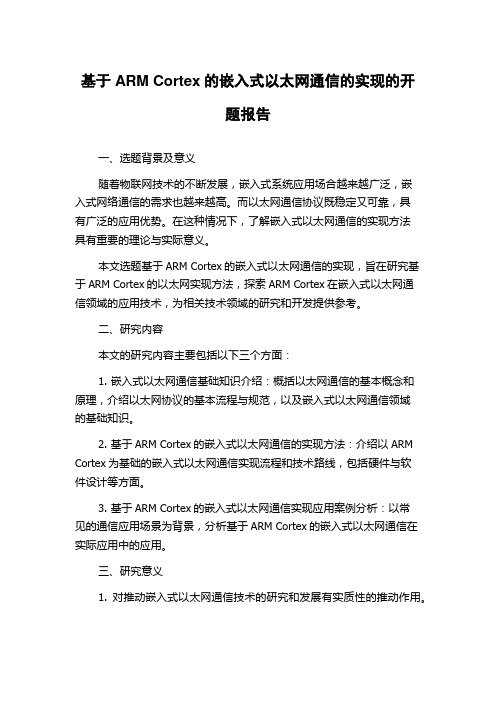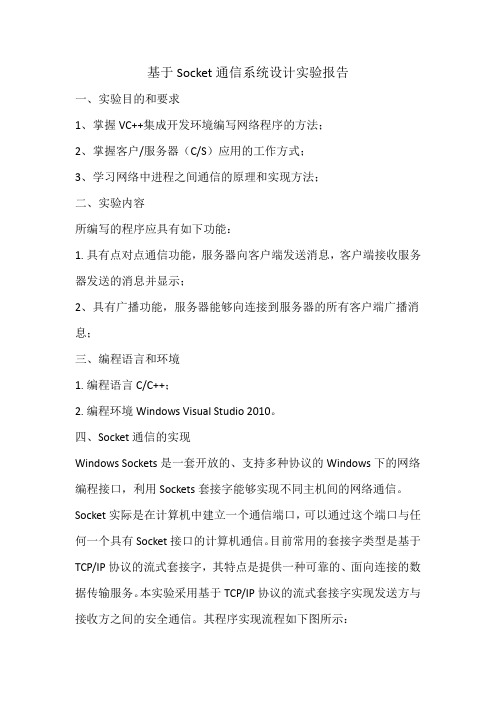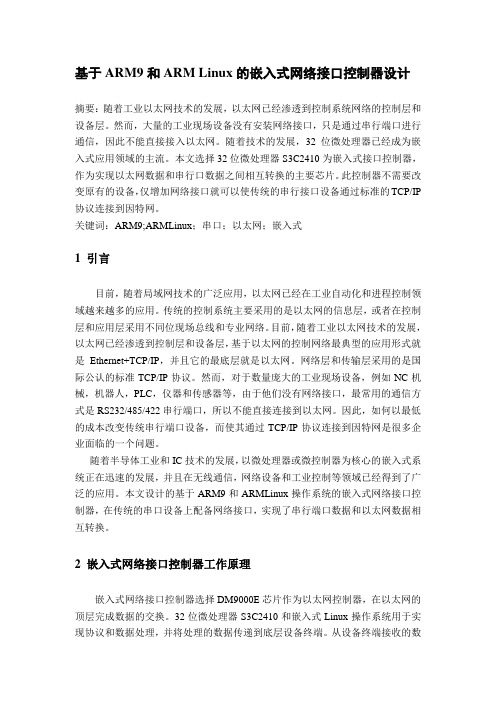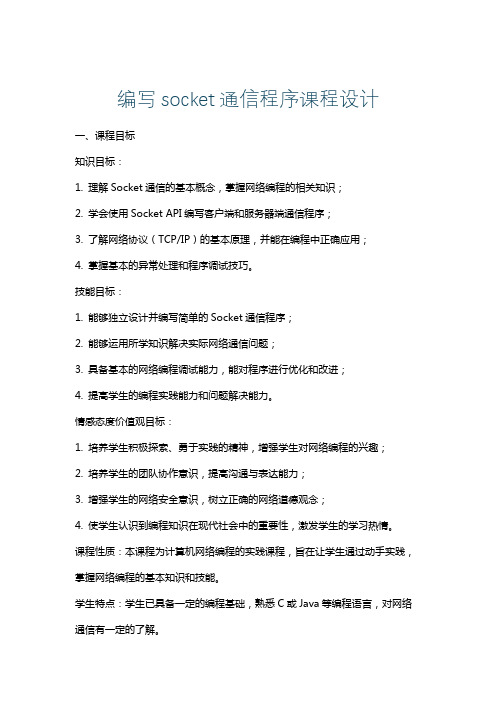(完整版)基于ARM嵌入式系统的Socket通信设计毕业设计
(完整版)基于ARM的嵌入式TCPIP协议的实现

嵌入式系统中网络通信协议的选择一、引言一个现代化工业企业的网络环境一般可分为四个层次:·Internet:实现企业之间的信息交流;·Intranet:实现企业内部管理、财务、办公及人事等的信息化;·Infranet:实现工业企业现场生产设备级的综合管理、调度与监控等;·Embedded Network :嵌入式网络。
实现生产设备内部多个分布式子系统之间的实时通信。
Internet、Intranet都基于TCP/IP协议簇,Intranet是面向广域网的Internet在企业内部局域网上的延伸。
Infranet的建设目前主要采用各种现场总线协议,如ProfiBus、Lonwork、CAN等。
随着社会的进步和技术的发展,现代机电控制系统往往包括若干个子系统,每个子系统既自成一体,拥有自己独立的CPU,又与其它子系统紧密协调。
嵌入式网络就是实现子系统间相互通信的手段。
二、对嵌入式网络的特殊要求嵌入式网络通常应用在环境比较恶劣的工业生产现场,因此在以下几个方面有其自身独特的要求:1. 实时性:生产设备内部多个分布式子系统信息耦合通常比较紧密,对实时性要求很高,这就要求所用的网络协议具有可确定的实时性能,即极坏情况下的响应时间是可确定的;另外在网络节点数比较多,或者有些节点对实时响应要求特别高时,网络协议还应支持优先级调度,以提高时间紧迫型任务的信息传输可确定性。
2. 可靠性:嵌入式网络本身的可靠性直接影响设备的有效作业率、成品率和生产效率,要求网络能动态增加/删除节点;生产现场比较恶劣的电磁环境要求嵌入式网络本身具有很强的抗干扰能力、检错和纠错能力以及快速恢复能力;3. 通信效率:嵌入式网络通信的特点之一是子系统之间通信非常频繁,但每次通信的信息长度很短,因此要求嵌入式网络协议尽量采用短帧结构,且帧头和帧尾尽可能短,从而提高通信效率和带宽的利用率;4. 双重混合支持:不同工作环境的巨大差异决定了嵌入式网络应具有灵活的介质访问协议,不但支持多种介质(双绞线、同轴电缆、光缆),而且支持混合拓扑结构(星型、环型、总线型),有时甚至要求同一个嵌入式网络能同时使用多种介质和多种网络拓扑。
(完整)使用socket进行通信程序设计

(完整)使用socket进行通信程序设计编辑整理:尊敬的读者朋友们:这里是精品文档编辑中心,本文档内容是由我和我的同事精心编辑整理后发布的,发布之前我们对文中内容进行仔细校对,但是难免会有疏漏的地方,但是任然希望((完整)使用socket进行通信程序设计)的内容能够给您的工作和学习带来便利。
同时也真诚的希望收到您的建议和反馈,这将是我们进步的源泉,前进的动力。
本文可编辑可修改,如果觉得对您有帮助请收藏以便随时查阅,最后祝您生活愉快业绩进步,以下为(完整)使用socket进行通信程序设计的全部内容。
使用socket进行通信程序设计姓名:学号:专业:2015年10月30日引言:“一切皆Socket!”.这话虽些许夸张,但是事实也是,现在的网络编程几乎都是用的socket。
当前是信息时代,网络的快速普及势不可挡,各种新兴应用也如雨后春笋般,层出不穷。
利用socket通信拥有即时通信功能的网络应用——聊天室,也因其为用户提供了实时性对话的渠道,深受青睐。
在本课程设计中,我个人选择C#语言实现了一个界面友好的网络聊天室,包括服务器端和客户端两个程序,可以支持多人进行文字聊天.基本原理:1、客户机/服务器模式在TCP/IP网络中两个进程间相互作用的主机模式是客户机/服务器模式(Client/Server model)。
该模式的建立基于以下两点:1、非对等作用;2、通信完全是异步的。
客户机/服务器模式在操作过程中采取的是主动请示方式:首先服务器方要先启动,并根据请示提供相应服务:(过程如下)① 打开一个通信通道(端口)并告知本地主机,并在某一个公认地址上接收客户请求;② 等待客户请求到达该端口;③ 接收到重复服务请求,处理该请求并发送应答信号;④ 返回第二步,等待另一客户请求;⑤关闭服务器。
客户方:①打开一个通信通道,并连接到服务器所在主机的特定端口;② 向服务器发送服务请求报文,等待并接收应答;继续提出请求……③ 请求结束后关闭通信通道并终止.2、套接字套接字是通信的基石,是支持TCP/IP协议的网络通信的基本操作单元。
基于ARM Cortex的嵌入式以太网通信的实现的开题报告

基于ARM Cortex的嵌入式以太网通信的实现的开题报告一、选题背景及意义随着物联网技术的不断发展,嵌入式系统应用场合越来越广泛,嵌入式网络通信的需求也越来越高。
而以太网通信协议既稳定又可靠,具有广泛的应用优势。
在这种情况下,了解嵌入式以太网通信的实现方法具有重要的理论与实际意义。
本文选题基于ARM Cortex的嵌入式以太网通信的实现,旨在研究基于ARM Cortex的以太网实现方法,探索ARM Cortex在嵌入式以太网通信领域的应用技术,为相关技术领域的研究和开发提供参考。
二、研究内容本文的研究内容主要包括以下三个方面:1. 嵌入式以太网通信基础知识介绍:概括以太网通信的基本概念和原理,介绍以太网协议的基本流程与规范,以及嵌入式以太网通信领域的基础知识。
2. 基于ARM Cortex的嵌入式以太网通信的实现方法:介绍以ARM Cortex为基础的嵌入式以太网通信实现流程和技术路线,包括硬件与软件设计等方面。
3. 基于ARM Cortex的嵌入式以太网通信实现应用案例分析:以常见的通信应用场景为背景,分析基于ARM Cortex的嵌入式以太网通信在实际应用中的应用。
三、研究意义1. 对推动嵌入式以太网通信技术的研究和发展有实质性的推动作用。
2. 为嵌入式系统开发和设计人员提供更加丰富的技术交流和学习空间。
3. 对企业相关技术、研发人员进行技术培训和应用培训等提供智力支撑。
四、预期成果本文预期取得以下成果:1. 深入了解嵌入式以太网通信领域的基础知识,掌握嵌入式以太网通信的工作原理和相关技术。
2. 研究并总结基于ARM Cortex的嵌入式以太网通信的实现方法,包括硬件设计和软件设计等方面。
3. 分析基于ARM Cortex的嵌入式以太网通信在实际应用中的应用案例,为技术人员提供技术参考。
5、论文结构第一章选题背景和意义第二章嵌入式以太网通信基础知识介绍2.1 以太网通信基本概念2.2 以太网协议流程与规范2.3 嵌入式以太网通信领域的基础知识第三章基于ARM Cortex的嵌入式以太网通信的实现方法3.1 硬件设计3.2 软件设计第四章基于ARM Cortex的嵌入式以太网通信实现应用案例分析第五章总结与展望参考文献。
毕业论文基于arm嵌入式系统的socket通信设计

毕业论文题目基于ARM嵌入式系统的Socket通信设计第I页摘要嵌入式系统是计算机技术、半导体技术和电子技术的综合体,已经广泛应用于科学研究、工程设计、国防军事、自动化控制等各个领域。
随着网络通讯技术的迅猛发展,生产和生活中广泛要求嵌入式系统终端能够完成网络通讯功能。
论文就是以ARM7 TDMI 为嵌入式开发平台,开发具有网络通信功能的嵌入式终端。
SOCKET是一个通信链的句柄,通过套接字向网络发出请求或者应答网络请求,用于TCP/IP协议的应用程序之间的相互通信。
论文选择了ARM体系结构的嵌入式LPC2200处理器,根据系统的需求,在综合各种设计方案的基础上,选择移植带有TCP/IP协议的ucLinux嵌入式操作系统。
裁剪和定制系统后,构建相关的文件系统。
在此基础上,编写应用程序,调用系统的Socket通信函数,实现服务器端和客户端的通信。
描述IP地址和端口,用于在两个论文成功的实现了嵌入式设备的网络接入功能,各个带有网络通讯功能的嵌入式终端可以相互通讯,扩大了和提高了嵌入式设备的应用范围,对嵌入式系统的发展有较大的意义。
关键词:嵌入式系统;ARM7TDMI;socket;TCP/IP第II页AbstractThe embedded system is a complex system with the computer technology, semiconductor technology and electronic technology .It has been widely used in scientific research, engineering, national defense, automation and other fields. With the rapid development of network communication technology,our production and life requires the terminal to complete the network communication function in a wide range of embedded systems. The Paper selectthe ARM7 TDMI for embedded development platform, develop the embedded network communication terminal.Socket is a communication chain handle, and sends network request or response to network requests. It is used to describe the IP address and port for both TCP / IP based protocol to communicate between applications,. The paper select LPC2200 embedded ARM as processor architecture, with the system need, design the integration based on transplantation with TCP / IP protocol ucLinux embedded operating system. The paper build related file system.after cutting and custom systems. On this basis, finished an application, and call the system function of Socket Communications, achieve server and client communication.The paper achieved the network access functions of the embedded device,the embedded with a network communication terminal can communicate with each other, and expand and improve the application range of embedded devices, and has a greater significance for embedded systems.Key words: Embedded Systems;ARM7TDMI;socket;TCP/IP第III页目录1绪论 (1)1.1嵌入式系统 (1)1.2国内外现状和趋势 (2)1.3选题必要性 (3)1.4选题的目的和意义 (4)1.5课题研究范围及要达到的技术要求 (5)2需求分析 (6)2.1任务概述 (6)2.2系统的需求分析 (6)2.2.1系统的功能需求 (6)2.2.2系统的性能需求 (6)2.3系统设计思路 (6)3系统概要设计 (9)3.1系统设计的基本原则 (9)3.2系统设计方案分析 (9)3.3概要设计 (11)3.3.1开发环境 (11)3.3.2ARM开发环境的建立 (12)3.3.3建立程序运行调试交叉编译环境 (15)3.4模块化的设计与分析 (15)3.4.1开发板上完成的设计 (15)3.4.2PC机上完成的程序开发 (16)3.5设计基本流程 (16)4系统详细设计 (19)4.1.U C LINUX的移植 (19)4.1.1uClinux嵌入式系统的下载 (19)4.1.2根文件系统的建立 (19)4.1.3应用程序库 (20)第IV页4.2.内核编译 (20)4.2.1uClinux的安装 (20)4.2.2配置uClinux (21)4.2.3构建文件系统 (23)4.3.PC机上的程序设计 (26)4.3.1嵌入式TCP /IP分析 (26)4.3.2嵌入式TCP/IP设计 (27)4.4.编程模型 (28)4.4.1TCP客户端设计 (28)4.4.2TCP服务器端主要代码分析 (30)4.5.程序下载到嵌入式硬件平台 (34)5系统的实现与测试 (37)5.1测试环境和测试的条件 (37)5.2功能及数据测试 (38)5.2.1容错功能 (38)5.2.2连接成功的信息说明 (39)5.2.3数据收发功能 (39)5.3测试的结果 (41)结论 (42)参考文献 (43)致谢 (45)。
基于socket通信系统设计

基于Socket通信系统设计实验报告一、实验目的和要求1、掌握VC++集成开发环境编写网络程序的方法;2、掌握客户/服务器(C/S)应用的工作方式;3、学习网络中进程之间通信的原理和实现方法;二、实验内容所编写的程序应具有如下功能:1. 具有点对点通信功能,服务器向客户端发送消息,客户端接收服务器发送的消息并显示;2、具有广播功能,服务器能够向连接到服务器的所有客户端广播消息;三、编程语言和环境1. 编程语言C/C++;2. 编程环境Windows Visual Studio 2010。
四、Socket通信的实现Windows Sockets是一套开放的、支持多种协议的Windows下的网络编程接口,利用Sockets套接字能够实现不同主机间的网络通信。
Socket实际是在计算机中建立一个通信端口,可以通过这个端口与任何一个具有Socket接口的计算机通信。
目前常用的套接字类型是基于TCP/IP协议的流式套接字,其特点是提供一种可靠的、面向连接的数据传输服务。
本实验采用基于TCP/IP协议的流式套接字实现发送方与接收方之间的安全通信。
其程序实现流程如下图所示:服务器端客户端1.服务器端首先调用socket函数来建立一个套接字;套接字创建成功后,调用bind函数将一个IP地址和端口号绑定到己经建立的socket上;绑定完成之后,服务器等待接收客户端的连接请求,调用listen函数实现监听的功能;监听到连接请求之后,服务器调用accept函数生成一个新的套接口描述符,以接受客户的连接请求,之后调用send/receive 函数在套接字上进行数据的读/写,直至完成交换;通信结束之后,调用close函数关闭套接字。
服务器socket通信程序://创建socket套接字连接if(m_hSocket != NULL){closesocket(m_hSocket);m_hSocket = NULL; }if(m_hSocket == NULL){m_hSocket = socket(AF_INET, SOCK_STREAM,0);ASSERT(m_hSocket != NULL); }m_addr.sin_family = AF_INET;m_addr.sin_addr.S_un.S_addr = INADDR_ANY;m_addr.sin_port = htons(m_nPort);int ret = 0,error = 0;ret = bind(m_hSocket, (LPSOCKADDR)&m_addr, sizeof(m_addr));if(ret == SOCKET_ERROR){TRACE("Bind Error: %d \n", (error = WSAGetLastError()));return ; }ret = listen(m_hSocket, 2);if(ret == SOCKET_ERROR){TRACE("Listen Error: %d \n", (error = WSAGetLastError()));return ; }SOCKET s = accept(m_hSocket, NULL, NULL);if(s == SOCKET_ERROR){TRACE("Accept Error: %d \n", (error = WSAGetLastError()));return ; }//监听接收到信息char buff[256];ret = recv(s, buff, 256, 0);if(ret == 0 || ret == SOCKET_ERROR ){TRACE("Recv data error: %d\n", WSAGetLastError());return ; }char* name = NULL;char* pass = NULL;int len = 0;len = buff[0];name = new char[len + 1];for(int i = 0; i < len; i++)name[i] = buff[i+1];int len2 = buff[len + 1];pass = new char[len2 + 1];for(int i = 0; i < len2; i++)pass[i] = buff[i + 2 + len];//发送消息代码CString str;if(strcmp(name, "ware") != 0){str = _T("用户名不正确!");TRACE(_T("用户名不正确!\n")); }else{if(strcmp(pass, "11111") != 0){str = _T("用户密码不正确!");TRACE(_T("用户密码不正确!\n")); } }if(str.IsEmpty()){ str =_T("我是马琰");str +=SendMsg; }char* buf = str.GetBuffer(0);ret = send(s, buf, str.GetLength(), 0);if(ret != str.GetLength()){TRACE("Send data error: %d\n", WSAGetLastError());return ; }2.客户端首先调用socket函数来建立一个套接字;成功创建套接字之后,再调用bind函数,将一个端口绑定到已经建立的socket上;之后客户端便可调用connect函数向服务器请求连接;通信连接建立之后,客户端则可通过调用send/receive函数完成数据交换;通信结束之后,关闭套接字。
基于ARM9和ARM Linux的嵌入式网络接口控制器设计___bak

基于ARM9和ARM Linux的嵌入式网络接口控制器设计摘要:随着工业以太网技术的发展,以太网已经渗透到控制系统网络的控制层和设备层。
然而,大量的工业现场设备没有安装网络接口,只是通过串行端口进行通信,因此不能直接接入以太网。
随着技术的发展,32位微处理器已经成为嵌入式应用领域的主流。
本文选择32位微处理器S3C2410为嵌入式接口控制器,作为实现以太网数据和串行口数据之间相互转换的主要芯片。
此控制器不需要改变原有的设备,仅增加网络接口就可以使传统的串行接口设备通过标准的TCP/IP 协议连接到因特网。
关键词:ARM9;ARMLinux;串口;以太网;嵌入式1 引言目前,随着局域网技术的广泛应用,以太网已经在工业自动化和进程控制领域越来越多的应用。
传统的控制系统主要采用的是以太网的信息层,或者在控制层和应用层采用不同位现场总线和专业网络。
目前,随着工业以太网技术的发展,以太网已经渗透到控制层和设备层,基于以太网的控制网络最典型的应用形式就是Ethernet+TCP/IP,并且它的最底层就是以太网。
网络层和传输层采用的是国际公认的标准TCP/IP协议。
然而,对于数量庞大的工业现场设备,例如NC机械,机器人,PLC,仪器和传感器等,由于他们没有网络接口,最常用的通信方式是RS232/485/422串行端口,所以不能直接连接到以太网。
因此,如何以最低的成本改变传统串行端口设备,而使其通过TCP/IP协议连接到因特网是很多企业面临的一个问题。
随着半导体工业和IC技术的发展,以微处理器或微控制器为核心的嵌入式系统正在迅速的发展,并且在无线通信,网络设备和工业控制等领域已经得到了广泛的应用。
本文设计的基于ARM9和ARMLinux操作系统的嵌入式网络接口控制器,在传统的串口设备上配备网络接口,实现了串行端口数据和以太网数据相互转换。
2 嵌入式网络接口控制器工作原理嵌入式网络接口控制器选择DM9000E芯片作为以太网控制器,在以太网的顶层完成数据的交换。
毕业设计(论文)样例-嵌入式专业本科

封面(在学校统一印制的封皮上打印相应的内容,以下为填写举例)论文题目 简化的姓名刘刚学院 东北大学东软信息学院 专 业指导教师 张三备 注2011年——作者指导教师: 张三 教授 李四 单位名称: 嵌入式系统工程系 专业名称: 电子信息工程东北大学东软信息学院2011年6月Northeastern University Neusoft Institute of InformationJune 2011Supervisor:Professor Liu Hongyi Associate Supervisor:毕业设计(论文)任务书………………………。
-Ⅱ-东北大学东软信息学院毕业设计(论文) Abstract-Ⅲ-computer network for a long time.This article mainly discusses the QoS architecture, the principle of V oIP and the two related protocols: H.323, SIP. And then, introduce some QoS control mechanisms: packet classification, admission control, QoS route and queue management.………………………………………………………………………………………………………………………………………………………………………………………………………………………………………………………………………………………………………………………………………………………………………………………………………………………………………………………………………………………………………………………………………………………………………………………………………………………………………………………………………………………………………….Key words: V oIP QoS, H.323 SIP RSVP Diffserv RTCP, dynamic control admission-1-任务书 .......................................................................................................... I 摘 要 .........................................................................................................II .. (III)第1章 ...................... 1 1.1 .. (1)1.2 (1)第2章 关键技术介绍 (2)2.1 简 ......................................2 2.2 .. (2)第3章 (3)3.1 (3)3.1.1 软件功能构架 ···············································3.1.2 硬件功能框图 ··············································· 3.2 系统开发环境3.3 ·3.3.1 (4)3.3.2 (4)第4章 系统设计 (6)4.1 设计指导思想和原则 (6)4.1.1 指导思想 ................................................................................................................ 6 4.1.2 设计原则 . (6)4.2 系统概述 (6)东北大学东软信息学院毕业设计(论文)目录4.3系统功能结构设计 (6)4.3.1实现单片机与外围存储器的技术连接 (6)4.3.2LED数码管的电路设计 (6)4.3.3rs232串行接口电路设计 (6)4.3.4键盘接口电路设计 (6)4.4系统UI界面设计 (6)4.5系统控制流程 (6)第5章系统实现 (7)5.1系统软件的实现 (7)5.1.1系统软件框图 (7)5.1.2系统程序流程图 (10)第6章系统测试 (12)6.1测试方案及测试用例 (12)6.1.1LED显示 (12)6.1.2键盘响应 (12)6.1.3串口收发 (12)6.1.3UI界面测试 (12)第7章结论 (13)附录1原理图 (14)附录2PCB图 (15)附录3实物图 (16)参考文献 (17)致谢 (18)-2-1章 绪论 说明:在绪论中简要说明设计(论文)工作的目的、意义、范围、研究设想、方法、选题依据等。
编写socket通信程序课程设计

编写socket通信程序课程设计一、课程目标知识目标:1. 理解Socket通信的基本概念,掌握网络编程的相关知识;2. 学会使用Socket API编写客户端和服务器端通信程序;3. 了解网络协议(TCP/IP)的基本原理,并能在编程中正确应用;4. 掌握基本的异常处理和程序调试技巧。
技能目标:1. 能够独立设计并编写简单的Socket通信程序;2. 能够运用所学知识解决实际网络通信问题;3. 具备基本的网络编程调试能力,能对程序进行优化和改进;4. 提高学生的编程实践能力和问题解决能力。
情感态度价值观目标:1. 培养学生积极探索、勇于实践的精神,增强学生对网络编程的兴趣;2. 培养学生的团队协作意识,提高沟通与表达能力;3. 增强学生的网络安全意识,树立正确的网络道德观念;4. 使学生认识到编程知识在现代社会中的重要性,激发学生的学习热情。
课程性质:本课程为计算机网络编程的实践课程,旨在让学生通过动手实践,掌握网络编程的基本知识和技能。
学生特点:学生已具备一定的编程基础,熟悉C或Java等编程语言,对网络通信有一定的了解。
教学要求:结合学生特点,注重理论与实践相结合,以项目为导向,培养学生的实际编程能力和解决问题的能力。
在教学过程中,关注学生的个体差异,提供有针对性的指导,确保课程目标的达成。
通过课程学习,使学生能够独立完成Socket通信程序的编写和调试。
二、教学内容1. 网络编程基础知识- 网络协议(TCP/IP)原理- IP地址、端口号、域名解析等基本概念2. Socket编程基本概念- Socket的定义与作用- 套接字类型(流式套接字、数据报套接字等)- Socket API介绍3. 客户端与服务器端编程- 客户端程序设计方法- 服务器端程序设计方法- 客户端与服务器端通信流程4. 编程实践- 使用C或Java等编程语言实现Socket通信- 编写简单的聊天程序、文件传输程序等案例5. 异常处理与调试技巧- 常见异常类型及处理方法- 网络编程中的调试技巧6. 网络安全与网络道德- 网络安全基础知识- 网络道德规范教学内容安排与进度:第1周:网络编程基础知识,学习网络协议原理及基本概念第2周:Socket编程基本概念,了解Socket API及其使用方法第3周:客户端与服务器端编程,学习编程方法和通信流程第4周:编程实践,动手编写Socket通信程序第5周:异常处理与调试技巧,学习调试方法和优化程序第6周:网络安全与网络道德,提高网络安全意识和网络道德观念教学内容与教材关联性:本教学内容紧密结合教材,按照教材章节顺序进行组织和安排,确保学生能够系统地学习网络编程知识。
基于ARM嵌入式的以太网通信程序设计.

1目次1 绪论 (2)1.1 课题研究背景及意义 (2)1.2 嵌入式系统的现状和发展趋势 (2)1.3 嵌入式网络的关键问题 (4)1.4 本论文的主要工作 (4)2 ARM嵌入式系统 (6)2.1 系统开发环境 (6)2.2 ARM嵌入式硬件平台 (6)2.3 搭建ARM嵌入式开发环境 (9)2.4 PC机Linux开发环境的建立 (22)2.5 本章小结 (22)3 ARM嵌入式以太网通信的开发 (24)3.1 OSI网络模型 (24)3.2 TCP/IP协议栈的基本概念 (24)3.3 TCP协议基本概念 (25)3.4 UDP协议 (28)3.5 本章小结 (29)4 ARM嵌入式的以太网通信程序设计 (31)4.1 TCP通信程序设计 (31)4.2 TCP网络程序设计流程 (33)4.3 TCP服务器/客户端网络程序的实现 (42)4.4 UDP通信程序设计 (46)4.5 UDP服务器/客户端网络程序的实现 (52)4.6 本章小结 (54)结论 (55)致谢 (56)参考文献 (57)附录 1 (58)附录 2 (61)附录 3 (64)1 绪论随着信息技术的迅猛发展,在我们的生活工作中,对于网络通信的要求逐年增高,且随着移动互联网络的发展与需求,嵌入式系统与通信网络,日日夜夜伴随着我们。
嵌入式系统与网络技术融合已经是必然的发展趋势,当嵌入式设备具有网络功能时,人们可以在任何地方、任何时间、任何平台随时浏览设备的信息,并进行操作和测试。
这是在嵌入式系统在其网络性和开放性的发展趋势。
1.1 课题研究背景及意义如今,我们的生活与工作中已经无法离开网络。
人们进行信息的传送和交流,之所可以实时且效地,恰是因为有“信息高速公路”,而“信息高速公路”的重要支撑网就是以太网[1]。
“以太(Ether)”这个词,是来源自十九世纪的物理学家们假设出的某种媒介,用以传播电磁波的辐射。
在下,他们认为“以太”充斥于世界各处,因此,到后来将“以太”这个假说引入到计算机局域网中,从而用来表现它在通信领域也是无处不在,就像“以太”充斥于世界中那样普遍存在。
基于ARM9的嵌入式Linux网络通信系统设计与实现

基于ARM9的嵌入式Linux网络通信系统设计与实现随着计算机技术的发展,嵌入式系统已经成为计算机领域的一个重要组成部分。
Internet现已成为社会重要的基础信息设施之一,是信息流通的重要渠道,如何让嵌入式设备连接到Internet上,和其他通信系统进行信息交换是当前嵌入式技术领域研究的热点所在。
本文结合实际应用需求,详细研究实现了一种基于S3C2410平台和Linux操作系统的嵌入式网络通信系统。
1.嵌入式网络通信系统总体设计经过大量的资料收集比较,深入地研究分析并结合现有的实验条件,我们对系统的体系结构、硬件平台和软件系统做出了以下选择:1)目前嵌入式CPU很多,选择哪款CPU要根据自己产品的实际需要。
一般而言,首先应尽量选择系统集成度高、外围电路简洁的CPU;其次,还应综合考察CPU的各项性能指标;最后,还应该考虑软硬件开发环境的建立、厂家的货源以及代理的软件支持力度。
经过比较, 本设计采用三星的S3C2410微处理器。
这是一款高性价比、低功耗、高集成度的CPU,基于ARM920T内核,主频最高为203MHz,专为手持设备和网络应用而设计,能满足嵌入式系统中的低成本、低功耗、高性能、小体积的要求。
图1为硬件平台的总体设计[ 1 ] 。
CPU S3C2410模块是开发板的核心部件。
S3C2410 在包含ARM920T核的同时,增加了丰富的外围资源,主要包括1个LCD 控制器,支持STN 和TFT液晶显示屏; 3个通道UART; 4个通道DMA; 4个具有PWM功能的16位定时/计数器和1个16位内部定时器, 支持外部时钟源; 8通道10位ADC,最高速率可达500kB / s;触摸屏、IIS总线、SD 卡和MMC卡接口;117位通用I/O口和24位外部中断源。
存储系统包括64MB的NAND Flash存储器模块和SDRAM存储器模块; Flash用于存放嵌入式操作系统、应用程序和用户数据等,并作嵌入式文件系统; SDRAM作为系统运行时的主要区域,用于存放系统及用户数据。
基于socket的即时通讯软毕业设计(论文) 推荐

长沙学院CHANGSHA UNIVERSITY毕业设计(论文)资料目录第一部分毕业论文一、毕业论文第二部分外文资料翻译一、外文资料原文二、外文资料翻译第三部分过程管理资料一、毕业设计(论文)课题任务书二、本科毕业设计(论文)开题报告三、本科毕业设计(论文)中期报告四、毕业设计(论文)指导教师评阅表五、毕业设计(论文)评阅教师评阅表六、毕业设计(论文)答辩评审表2009届本科生毕业设计(论文)资料第一部分毕业论文(2009届)本科生毕业论文基于socket的即时通讯软件2009年 6 月长沙学院本科生毕业论文基于socket的即时通讯软件系(部):电子与通信工程专业:通信工程学号: 2005043201学生姓名:闫成超指导教师:张明高级工程师2009 年6 月摘要近些年来,随着计算机技术的飞快发展,尤其是计算机网络方面的发展,人们的生活得到了彻彻底底的改变,人们能以非常低廉的价格,甚至不用花钱,就可以用上更方便、更实用的网络通信软件。
现在,网络上的在线服务系统多种多样,它们已经深深的影响并改变了人们的联系和交流方式,使得人们可以在千里之遥进行即时性的通讯。
过去的种种陈旧的通讯方式,已经不能满足现代生活的需要。
即时通讯软件作为一种方便人与人之间联系的实用工具应运而生,为我们的学习和工作,带来了极大的方便,很大程度的提高了学习和工作效率。
由于即时通讯软件的外观友好、使用非常方便,而且使用者之间的通讯是即时互动的特点,受到大多数人的喜欢,这一类通讯软件的应用市场特别广阔。
现如今,很多的企业、机关、学校都纷纷建立起自己的局域网。
于是我就想到做一个在局域网里的多功能通讯软件,在局域网里,我们可以通过它,实现在局域网里联络,消息的发布等。
在学校建立的校园网里,这软件可以方便同学之间、教师之间、师生之间即时性的联络,这样,不用上Internet,可以节省资源。
在学校这个大环境里,这个软件可以方便同学之间联系,促进同学之间的友谊,学生可以通过它来与不同寝室的同学,与教师讨论问题,并能最大限度地利用现有的网络资源,极大地提高工作效率。
基于ARM的嵌入式系统设计硕士学位论文

硕士学位论文基于ARM的嵌入式系统设计第一章摘要嵌入式系统以其小型、专用、易携带、可靠性高的特点,已经在各个领域得到了广泛的应用,如军事国防、消费电子、通信设备、工业控制等。
嵌入式处理器内嵌实时操作系统(RTOS),具有实时性、低成本、小型化、专用化和高可靠性,克服了传统的基于单片机控制系统功能不足和基于PC的系统非实时性的缺点。
随着嵌入式系统软硬件技术的飞速发展,其应用领域必将更为广阔,嵌入式系统的研究将会有非常广泛的前景。
本课题的目的就是研究适用于学校教学的嵌入式系统平台,这对于提高对嵌入式系统的理解具有重要意义。
本课题以嵌入式系统设计原理和实际应用为核心,从理论上和技术方法上开展了一系列研究。
主要工作有: 1、全面系统地概述了嵌入式系统的发展过程和分类,及其在各个领域内的应用,以及嵌入式系统的发展方向;2、基于嵌入式系统设计原理的嵌入式开发平台的设计的总体方案,从硬件和软件两个方面讲述了嵌入式系统的设计思想和方法,及其可行性的论证;3、嵌入式系统硬件平台的设计与调试,着重叙述了硬件平台的整体设计方案,包括各个设计模块的选型与接口电路的设计;4、嵌入式系统所采用的操作系统的移植与调试,详细讲叙了µC/OS-II实时操作系统在基于LPC2136的嵌入式控制器硬件平台上的移植过程及注意事项;5、对µC/OS-II内核实时性能进行了深入的分析,通过实际测试得出了在特定条件下µC/OS-II的实时响应参数。
6、在后继的工作中,我们还要在实时嵌入式操作系统的基础上完成对操作系统的扩展以及对各个模块的驱动。
总之,本文完成了嵌入式系统的硬件平台构架、实时嵌入式操作系统的移植,为今后嵌入式系统的后继开发提供了一个嵌入式平台。
关键词:嵌入式系统ARM RTOS µC/OS-II第二章AbstractWith the development of IT network technology, embedded system shows a new direction of technology development. Embedded system has been applied in military, electronics, communication, industrial control and so on, with respect to its small size, high performance, low cost, high reliability and oriented object program.Embedded controller with RTOS gets over the traditional microcontroller and the disadvantage of the un-real time specialty base on pc, instead it is real-time, low cost ,miniaturized ,customized ,and high dependability. It also has a broad foreground , along with the fast development of hardware of embedded system .This intention of this topic is designing the embedded system, which is important for enhancing the understanding of embedded system. The research is highlighted in both design theory and applications of embedded system, which extended its developments. This paper is organized into six parts:1. This article essentially introduced the development of embedded system, its classification, applications in numerous areas, and its development orientation.2. The second chapter covers the general design of the embedded system, based on the elements of embedded system design. then it shows the devise ideology and methods in either hardware or software, and the demonstration of its accessibility.3. The third chapter gives out the hardware of the embedded system, including design, test and implementation of each module, as well as their interface circuitry.4. The forth chapter introduces the process and attentions of RTOS µC/OS-II, when explanted to the LPC2136 embedded controller hardware platform.5. It covers a in-dept analyzing in the real-time performance in μC/OS-II core, as well as the real time respond parameter in the very condition.6. In the future, we will expand the operation system based on RTOS, and derivations of each module.In a word, the article provides keen insight into the platform architecture of hardware and explants of the RTOS, in addition to affording an embedded platform for the subsequence developments.Key word: embedded system ARM RTOS µC/OS-II目录第一章绪论......................................................................... 错误!未定义书签。
ARM的嵌入式无线通信实验设计-实验设计论文-设计论文

ARM的嵌入式无线通信实验设计-实验设计论文-设计论文——文章均为WORD文档,下载后可直接编辑使用亦可打印——摘要:在工业4.0时代,市场对高端计算机人才的需求居高不下,计算机专业应在理论教学同时,注重学生实践能力的培养,实验是实践教育的关键措施之一。
本文将基于ARM的嵌入式无线通信实验设计为研究对象,从基于ARM的嵌入式无线通信实验特点入手,以BootLoader、uClinbux根文件系统与视频通信系统为例,论述实验设计要点,为高校教师提供成功经验参考。
关键词:ARM;嵌入式系统;无线通信前言在高校计算机专业中,嵌入式系统课程属于软硬协同设计课程,为专业核心课程,理论知识较丰富,覆盖范围较广。
但在嵌入式系统课程实验设计中,高校教师以嵌入式系统实验为主,并未将嵌入式系统与行业先进技术整合。
就此,基于ARM的嵌入式系统无线通信实验设计具有鲜明现实意义,可将嵌入式系统与无线通信技术整合,满足当前万物互联的通信需求,有效发展学生实践素养。
1基于ARM的嵌入式无线通信实验特点1.1实验系统配置在基于ARM的嵌入式系统无线通信实验中,实验系统配置为实验设计的基础。
通常来说,嵌入式系统的配置如下:(1)PC机,即计算机硬件设备,是无线通信实验系统的控制端,负责输入/输出信息、接收命令,如操作反馈信息、硬件信息等;(2)嵌入式系统开发板,为uClinux操作系统的运行程序,负责根据输入的命令执行程序,如通过程序运行实现PC机和GPRS终端的数据通信;(3)GPRS终端,主机输入命令的最终执行者,在实施无线网接入等通信功能时,均由GPRS终端的外接天线负责。
通常来说,可利用GPRS的RS232接口,连接嵌入式系统的实验开发板,保障通信实验过程中各项数据的有效联通,为实验的有序进行提供保障[1]。
1.2系统平台建构要求在建构实验系统平台时,嵌入式系统的配置选择为重点,具体要求如下:在实验开发板选择中,优先选择ARM微处理器,该设备具有低功耗、体积小、性能优异、应用灵活、执行效率高等优势。
毕业设计(论文)-基于socket的文件传输系统[管理资料]
![毕业设计(论文)-基于socket的文件传输系统[管理资料]](https://img.taocdn.com/s3/m/e4fc6fe252d380eb63946d83.png)
传输层对应于OSI参考模型的传输层,为应用层实体提供端到端的通信功能。该层定义了两个主要的协议:传输控制协议(TCP)和用户数据报协议(UDP)。TCP协议提供的是一种可靠的、面向连接的数据传输服务;而UDP协议供的是不可靠的、无连接的数据传输服务。
Keywords:Java; Peer-to-peer; Socket connection
1
当今世界科学技术飞速发今天,借助于网络进行信息资源交流给人们带来了极大的方便。各种文件传输系统都已被广大用户接受。比如QQ、UC、Internet邮件等互联网上的文件传输。甚至需要花费大量的金钱购买各种移动磁盘或者其他局域网内连接主机的硬件设备。而达到的效果却总是因为传输效率以及安全威胁而受到很大的限制。在这种形势下,开发一个功能简单而实用,能在Windows操作系统中运行,并且具有可移植性的局域网内文件传输工具势在必行。
密级公开学号
XX学院
毕业论文(设计)
基于socket的局域网文件传输系统
论文作者
指导教师
所属学院
专业
本科专科
年级
论文提交日期
论文答辩日期
xxx
xxx
数学与计算机学院
计算机科学与技术
本科
2007级
2011年5月20日
2011年5月 28日
毕业论文(设计)学术承诺
本人郑重承诺:,论文中不存在抄袭情况,论文中不包含其他人已经发表的研究成果,也不包含他人或其他教学机构取得的研究成果.
网络上的两个程序通过一个双向的通讯连接实现数据的交换,这个双向链路的一端称为一个Socket。Socket通常用来实现客户方和服务方的连接。Socket是TCP/IP协议的一个十分流行的编程界面,一个Socket由一个IP地址和一个端口号唯一确定。
毕业设计 外文资料 基于socket的网络编程

Programming Overlay Networks with Overlay SocketsThe emergence of application-layer overlay networks has inspired the development of new network services and applications. Research on overlay net-works has focused on the design of protocols to maintain and forward data in an overlay network, however, less attention has been given to the software development process of building application programs in such an environment. Clearly, the complexity of overlay network protocols calls for suitable application programming interfaces (API) and abstractions that do not require detailed knowledge of the overlay protocol, and, thereby, simplify the task of the application programmer. In this paper, we present the concept of an overlay socket as a new programming abstraction that serves as the end point of communication in an overlay network. The overlay socket provides a socket-based API that is independent of the chosen overlay topology, and can be configured to work for different overlay topologies. The overlay socket can support application data transfer over TCP, UDP, or other transport protocols. This paper describes the design of the overlay socket and discusses API and configuration options.1 IntroductionApplication-layer overlay networks provide flexible platforms for developing new network services without requiring changes to the network-layer infrastructure. Members of an overlay network, which can be hosts, routers, servers, or applications, organize themselves to form a logical network topology, and communicate only with their respective neighbors in the overlay topology. A member of an overlay network sends and receives application data, and also forwards data intended for other members. This paper addresses application development in overlay networks. We use the term overlay network programming to refer to the software development process of building application programs that communicate with one another in an application-layer overlay. This work is supported in part by the National Science Foundation through grant ANI-0085955 network. The diversity and complexity of building and maintaining overlay networks make it impractical to assume that application developers can be concerned with the complexity of managing the participation of an application in a specific overlay network topology.We present a software module, called overlay socket that intends to simplify the taskof overlay network programming. The design of the overlay socket pursues the following set of objectives: First, the application programming interface (API) of the overlay socket does not require that an application programmer has knowledge of the overlay network topology. Second, the overlay socket is designed to accommodate different overlay network topologies. Switching to different overlay network topologies is done by modifying parameters in a configuration file. Third, the overlay socket, which operates at the application layer, can accommodate different types of transport layer protocols. This is accomplished by using network adapters that interface to the un-delaying transport layer network and perform encapsulation and de-encapsulation of messages exchanged by the overlay socket. Currently available network adapters are TCP, UDP, and UDP multicast. Fourth, the overlay socket provides mechanisms for bootstrapping new overlay networks. In this paper, we provide an overview of the overlay socket design and discuss over-lay network programming with the overlay socket. The overlay socket has been implemented in Java as part of the Hyper Cast 2.0 software distribution. The software has been used for various overlay applications, and has been tested in both local-area as well as wide-area settings. The Hyper Cast 2.0 software implements the overlay topologies described in and this paper highlights important issues of the overlay socket, additional information can be found in the design documentation available from several studies before us have addressed overlay network programming issues. Even early overlay network proposals, such as Yoid, Scribe, and Scattercast, have presented APIs that aspire to achieve independence of the API from the overlay network topology used. Particularly, Yoid and Scattercast use a socket-like API, how-ever, these APIs do not address issues that arise when the same API is used by different overlay network topologies. Several works on application-layer multicast overlays integrate the application program with the software responsible for maintaining the overlay network, without explicitly providing general-purpose APIs. These include Narada, Overcast, ALMI, and NICE. A recent study has proposed a common API for the class of so-called structured overlays, which includes Chord, CAN, and Bayeux, and other overlays that were originally motivated by distributed hash tables. Our work has a different emphasis than since we assume a scenario where an application programmer must work with several, possibly fundamentally different, overlay network topologies and different transmission modes (UDP, TCP), and, therefore, needs mechanisms that make it easy to change theconfiguration of the un-delaying overlay network.Fig. 1. The overlay network is a collection of overlay sockets. Root (sender) Root (receiver) (a) Multicast (b) Unicast.Fig. 2. Data forwarding in overlay networks.The rest of the paper is organized as following. In Section 2 we introduce concepts, abstractions, and terminology needed for the discussion of the overlay socket. In Section 3 we present the design of the overlay socket, and discuss its components. In Section 4 we show how to write programs using the overlay socket. We present brief conclusions in Section 5.2 Basic ConceptsAn overlay socket is an endpoint for communication in an overlay network, and an overlay network is seen as a collection of overlay sockets that self-organize using an overlay protocol (see Figure 1). An overlay socket offers to an application programmer a Berkeley socket-style API for sending and receiving data over an overlay network. Each overlay socket executes an overlay protocol that is responsible for maintaining the membership of the socket in the overlay network topology. Each overlay socket has a logical address and a physical address in the overlay network. The logical address is dependent on the type of overlay protocol used. In the overlay protocols currently implemented in Hyper Cast 2.0, the logical addresses are 32- bit integers or _ x _ y _coordinates, where x and y are positive 32-bit positive integers. The physical address is a transport layer address where overlay sockets receive messages from the overlay network. On the Internet, the physical address is an IP address and a TCP or UDP port number. Application programs that use overlay sockets only work with logical addresses, and do not see physical addresses of overlay nodes. When an overlay socket is created, the socket is configured with a set of configuration parameters, called attributes. The application program can obtain the attributes from a configuration file or it downloads the attributes from a server. The configuration file specifies the type of overlay protocol and the type of transport protocol to be used, but also more detailed information such as the size of internal buffers, and the value of protocol-specific timers. The most important attribute is the overlay identifier (overlay ID) which is used as a global identifier for an overlay network and which can be used as a key to access the other attributes of the overlay network. Each new overlay ID corresponds to the creation of a new overlay network.Overlay sockets exchange two types of messages, protocol messages and application messages. Protocol messages are the messages of the overlay protocol that maintain the overlay topology. Application messages contain application data that is encapsulated an overlay message header. An application message uses logical addresses in the header to identify source and, for unicast, the destination of the message. If an overlay socket receives an application message from one of its neighbors in the over-lay network, it determines if the message must be forwarded to other overlay sockets, and if the message needs to be passed to the local application. The transmission modes currently supported by the overlay sockets are unicast, and multicast. In multicast, all members in the overlay network are receivers. In both unicast and multicast, the common abstraction for data forwarding is that of passing data in spanning trees that are embedded in the overlay topology. For example, a multicast message is transmitted downstream a spanning tree that has the sender of the multicast message as the root (see Figure 2(a)). When an overlay socket receives a multicast message, it forwards the message to all of its downstream neighbors (children) in the tree, and passes the message to the local application program. A unicast message is transmitted upstream a tree with the receiver of the message as the root (see Figure 2(b)). An overlay socket that receives a unicast message forwards the message to the upstream neighbor (parent) in the tree that has the destination as the root. An overlay socket makes forwarding decisions locally using only the logical ad-dresses of its neighbors and the logical address of the root of the tree. Hence, there is a requirement that each overlay socket can locally compute its parent and its children in a tree with respect to a root node. This requirement is satisfied by many overlay network topologies.3 The Components of an Overlay SocketAn overlay socket consists of a collection of components that are configured when the overlay socket is created, using the supplied set of attributes. These components include the overlay protocol, which helps to build and maintain the overlay network topology, a component that processes application data, and interfaces to a transport-layer network. The main components of an overlay socket, as illustrated in Figure 3, are as follows:The overlay node implements an overlay protocol that establishes and maintains the overlay network topology. The overlay node sends and receives overlay protocolmessages, and maintains a set of timers. The overlay node is the only component of an overlay socket that is aware of the overlay topology. In the Hyper Cast 2.0. Overlay socketForwarding EngineApplication Programming InterfaceStatistics InterfaceProtocol MessagesApplicationReceiveBufferApplicationTransmitBuffer Overlay NodeOverlay NodeInterfaceNode AdapterAdapter InterfaceSocket AdapterAdapter InterfaceApplication MessagesApplication ProgramTransport-layer NetworkApplication MessagesFig. 3. Components of an overlay socket software, there are overlay nodes that build a logical hypercube and a logical Delaunay triangulation.The forwarding engine performs the functions of an application-layer router that sends, receives, and forwards formatted application-layer messages in the overlay network. The forwarding engine communicates with the overlay node to query next hop routing information for application messages. The forwarding decision is made using logical addresses of the overlay nodes. Each overlay socket has two network adapters that each provides an interface to transport-layer protocols, such as TCP or UDP. The node adapter serves as the interface for sending and receiving overlay protocol messages, andthe socket adapter serves as the interface for application messages. Each adapter has a transport level address, which, in the case of the Internet, consists of an IP address and a UDP or TCP port number. Currently, there are three different types of adapters, for TCP, UDP, and UDP multicast. Using two adapters completely separates the handling of messages for maintaining the overlay protocol and the messages that transport application data.The application receive buffer and application transmit buffer can temporarily store messages that, respectively, have been received by the socket but not been delivered to the application, or that have been released by the application program, but not been transmitted by the socket. The application transmit buffer can play a role when messages cannot be transmitted due to rate control or congestion control constraints. The application transmit buffer is not implemented in the Hyper Cast 2.0 software. Each overlay socket has two external interfaces. The application programming interface (API) of the socket offers application programs the ability to join and leave existing overlays, to send data to other members of the overlay network, and receive data from the overlay network. The statistics interface of the overlay socket provides access to status information of components of the overlay socket, and is used for monitoring and management of an overlay socket. Note in Figure 3 that some components of the overlay socket also have interfaces, which are accessed by other components of the overlay socket. The overlay manager is a component external to the overlay socket (and not shown in Figure 3). It is responsible for configuring an overlay socket when the socket is created. The overlay manager reads a configuration file that stores the attributes of an overlay socket, and, if it is specified in the configuration file, may access attributes from a server, and then initiates the instantiation of a new overlay socket.4 Overlay Network ProgrammingAn application developer does not need to be familiar with the details of the components of an overlay socket as described in the previous section. The developer is exposed only to the API of the overlay socket and to a file with configuration parameters. The configuration file is a text file which stores all attributes needed to configure an overlay socket. The configuration file is modified whenever a change is needed to the transport protocol, the overlay protocol, or some other parameters of the overlay socket. In the following, we summarize only the main features of the API, and we refer to fordetailed information on the overlay socket API.4.1 Overlay Socket APISince the overlay topology and the forwarding of application-layer data is transparent to the application program, the API for overlay network programming can be made simple. Applications need to be able to create a new overlay network, join and leave an existing overlay network, send data to and receive data from other members in the overlay.The API of the overlay socket is message-based, and intentionally stays close to the familiar Berkeley socket API. Since space considerations do not permit a description of the full API, we sketch the API with the help of a simplified example. Figure 4 shows the fragment of a Java program that uses an overlay socket. An application program configures and creates an overlay socket with the help of an overlay manager. The overlay manager reads configuration parameters for the overlay socket from a configuration file (hyper cast prop), which can look similarly as shown in Figure 5. The application program reads the overlay ID with command on get Default Property(“OverlayID”) from the file, and creates an configuration object (config) for an overlay socket with the.// generate the configuration objectOverlayManager om = newOverlayManager("hypercast.prop");String MyOverlay = om.getDefaultProperty("OverlayID");OverlaySocketConfig config = new om.getOverlaySocketConfig(MyOverlay);// create an overlay socketOL Socket socket = config.createOverlaySocket(callback);// Join an overlaysocket.joinGroup();// Create a messageOL Message msg = socket.createMessage(byte[] data, int length);// Send the message to all members in overlay networksocket.sendToAll(msg);// Receive a message from the socketOL Message msg = socket.receive();Fig. 4. Program with overlay sockets.# OVERLAY Server:OverlayServer =# OVERLAY ID:OverlayID = 1234KeyAttributes= Socket,Node,SocketAdapter# SOCKET:Socket = HCast2-0HCAST2-0.TTL = 255HCAST2-0.ReceiveBufferSize = 200# SOCKET ADAPTER:SocketAdapter = TCPSocketAdapter.TCP.MaximumPacketLength = 16384# NODE:Node = DT2-0DT2-0.SleepTime = 400# NODE ADAPTER:NodeAdapter = NodeAdptUDPServerNodeAdapter.UDP.MaximumPacketLength = 8192NodeAdapter.UDPServer.UdpServer0 =128.143.71.50:8081Fig. 5. Configuration file (simplified) given overlay ID. The configuration object also loads all configuration information from the configuration file, and then creates the overlay socket (config create Overlay Socket).Once the overlay socket is created, the socket joins the overlay network (socket join Group). When a socket wants to multicast a message, it instantiates a new message (socket create Message) and transmits the message using the send to all method. Other transmission options are send-To-Parent, send-To-Children, sendToNeighbors, and sendToNode, which, respectively, send a message to the upstream neighbor with respect to a given root (see Figure 2), to the downstream neighbors, to all neighbors, or to a particular node with a given logical address.4.2 Overlay Network Properties ManagementAs seen, the properties of an overlay socket are configured by setting attributes in a configuration file. The overlay manager in an application process uses the attributes to create a new overlay socket. By modifying the attributes in the configuration file, an application programmer can configure the overlay protocol or transport protocol that is used by the overlay socket. Changes to the file must be done before the socket is created. Figure 5 shows a (simplified) example of a configuration file. Each line of the configuration file assigns a value to an attribute. The complete list of attributes and the range of values is documented. Without explaining all entries in Figure 5, the file sets, among others, the overlay ID to …1234 ‟, selects version 2.0 of the DT protocol as overlay protocol (…Node=DT2-0 ‟), and it sets the transport protocol of the socket adaptor to TCP(…Socket Adapter=TCP ‟).Each overlay network is associated with a set of attributes that characterize the properties of the overlay sockets that participate in the overlay network. As mentioned earlier, the most important attribute is the overlay ID, which is used to identify an y network, and which can be used as a key to access all other attributes of an overlay network. The overlay ID should be a globally unique identifier.A new overlay network is created by generating a new overlay ID and associating a set of attributes that specify the properties of the overlay sockets in the overlay network. To join an overlay network, an overlay socket must know the overlay ID and the set of attributes for this overlay ID. This information can be obtained from a configuration file, as shown in Figure 5.All attributes have a name and a value, both of which are strings. For example, the overlay protocol of an overlay socket can be determined by an attribute with name NODE. If the attribute is set to NOD-E=DT2- 0, then the overlay node in the overlay socket runs the DT (version 2) overlay protocol. The overlay socket distinguishes between two types of attributes: key attributes and configurable attributes. Key attributes are specific to an overlay network with a given overlay ID. Key attributes are selected when the overlay ID is created for an overlay network, and cannot be modified after-wards.Overlay sockets that participate in an overlay network must have identical key attributes, but can have different configurable attributes. The attributes OverlayID and Key Attributes are key attributes by default in all overlay networks. Configurable at-tributes specify parameters of an overlay socket, which are not considered essential forestablishing communication between overlay sockets in the same overlay network, and which are considered …tunable‟.5 ConclusionsWe discussed the design of an overlay socket which attempts to simplify the task of overlay network programming. The overlay socket serves as an end point of communication in the overlay network. The overlay socket can be used for various overlay topologies and support different transport protocols. The overlay socket supports a simple API for joining and leaving an overlay network, and for sending and receiving data to and from other sockets in the overlay network. The main advantage of the overlay socket is that it is relatively easy to change the configuration of the overlay network. An implementation of the overlay socket is distributed with the HyperCast2.0 soft-ware. The software has been extensively tested. A variety of different applications, such as distributed whiteboard and a video streaming application, have been developed with the overlay sockets.Acknowledgment. In addition to the authors of this article the contributors include Bhupinder Sethi, Tyler Beam, Burton Filstrup, Mike Nahas, Dongwen Wang, Konrad Lorincz, Jean Ablutz, Haiyong Wang, Weisheng Si, Huafeng Lu, and Guangyu Dong.基于Socket的网络编程应用层覆盖网络的出现促进了新网络服务和应用的发展。
基于ARM平台的嵌入式系统接口的设计与实现

计 算机 与 网络
基 于 A M 平 台 晌 嵌兀 式 系 统捷 口 硇 设 计 与实 坝 R
锦 州师 范 高等 专科 学校
以太网是 当今最受欢迎的局域网之一 , 其技术现在已经很 成熟 , 建 网灵活且成本低廉 , 市场上相关产 品也很丰富。以太网包括 了 O I S 七层 模型中物理层和数据链 路层的全部 内容 , 近些年 A RM技术的发展加速 了其在嵌入式 的应用范围。如果将 A M 和以太 网连接起 来 , R 将大大促 进嵌入式 系统在 网络领域的应用 。 但是 , 嵌入式系统与网络连接存 在着 困难 , 这有 两方面的原因。一 方面 , 的各种通讯协议很 复杂 , 于处理器 的要求 比较 高。另 一方 网络 对 面, 嵌入式系统微处理器的资源很有 限。本文通过对 A M微处理 器和 R 以太网的分析 , 提出了基于 A M平台的嵌入式 系统 与以太 网络连 接的 R 网络通信接 口系统的软硬件实现方案。 1系统 硬件 的设 计 与 实 现 . 11 .实现的原理 和技术特点 SC 40 3 4 B x内嵌一个 以太 网控 制器 , 支持 媒体独立接 口1mei i— 1 da n 1 ( dpn etnefc , I和带 缓 冲 D z接 口f f rdD t f e e edn t aeMI i r ) MAt] 3 b ee MA i e a , u n rc B )可在半双工或全双工模式下提供 1M/0 Mb s的以太网接入。 DI . 0 10 p 在 半双工模 式下 ,控制器支持 C MAC S /D协议 ;在全双工模式 下 ,支持 IE 8 23MA E E 0 _ C控 制层 协 议 。 因此 ,3 4 B x内部虽然 包含了以太网 MA SC4 0 C控制器 , 但并未提供 物理层接 口, 因此 , 需外接一 片物理 层芯片 以提供 以太 网的接 入通道 。 而常用的单 口 1M 1O b s 0 / M p 高速以太网物理层接 口器件均提供 M I 0 I接 口和传统 7线制 网络接 口, 可方便地 与 S C 4 0 3 4 B x接 口。以太 网物理层 接 口器 件 主要 功 能 一 般 包 括 : 理 编码 子 层 、 理 媒 体 附件 、 绞 线 物 物 物 双 理媒体子层 、0 A E T 1B S — X编码 , 解码器和双绞线媒体访 问单元等 。 使用 R L 0 9 S作为以太 网的物理层接 口, 的基本工作原理是 : T 81A 它 在收到 由 主机发来 的数据报后 , 侦听网络线路。如果线路忙 , 就等到线路空闲为 止, 否则 , 即发 送该 数据帧 。在发送过程 中 , 立 首先它添加 以太 网帧头 泡 括前导字段和帧开始标志)然后生成 C , RC校 验码 , 最后将 此数据帧 发送到以太 网上 。在接收过程中 ,将从 以太 网收到的数据 帧在经 过解 码、 去帧头和地址检验等步骤后缓存在片内。在 C C校验通过后 , R 它会 根据初始化配置的情况 , 知 R L 0 9 S收到 了数据帧 , 通 T 8 1A 最后 , 用某种 传输模式 (o模 式 、 mo u Me  ̄模 式 、 MA模式) D 传到 S C 4 0 3 4 B x的存储 区 中。 1 . 2该系统的硬件 电路 瑞昱公 司的 R L 0 9 S T 8 1 A 芯片集成了介质访问控制子层( A ) M C和物 理层 (H ) P Y 的功能 , 能与大多数通用 MC U进行接 口, 较高 的性价 比使其 成为一款广泛使用 的 1Mb s 0 p 全双工以太网控制器 。此外 , T S 9 S R L O1A 还与 N 2 0 E 0 0兼容 , 从而具有很好的软件移植性能 。 R L 0 9 S有 3种接 口模 式 , T 8 1A 分别为跳线模式 、NP模式和 R P T模 式 , 两种又可以统称为非跳线模式 , 后 工作 在非跳线模式 时需要 E P E— RO M作 为配置存储器。R L 0 9 S的 6 T 8 1A 5脚 - I P决定跳线模式和非跳线 模式 , 系统采用跳线模式 ,5脚 J 拉至 V C 这样 E P OM芯片 本 6 P上 C, ER 可 以省 去 。
第五章-基于ARM的嵌入式程序设计

分配一段字对齐的字内存单元。
为双精度的浮点数分配字对齐的内存单元。
为单精度的浮点数分配字对齐的内存单元。
在ARM代码中分配一段字对齐的内存单元; 在Thumb代 码中,分配一段半字对齐的半字内存单元。
{label} DCQ{U}{﹣} 分配一段以双字(8个字节)为单位的内存 literal{,{﹣}literal}… {label} DCW{U}expr{, D. CW用于分配一段半字对齐的半字内存单元。 expr}…
汇编控制伪操作
伪操作
语法格式
作用
IF , ELSE 及 ENDIF
IF logical expression … {ELSE …} ENDIF
WHILE 及 WEND
WHILE logical expression … WEND
能够根据条件把一段源代码包括在汇编 语言程序内或者将其排除在程序之外。
能够根据条件重复汇编相同的一段源代 码。
MACRO 、 MEND 及
MEXIT
MACRO
{$label} macroname {$parameter{,
$parameter}…}
…
;宏代码
MEND
MACRO标识宏定义的开始,MEND标 识宏定义的结束。MERIT用于从宏中跳 转出去。用MACRO和MEND定义的一 段代码,称为宏定义体。通过宏名称来 调用宏。
string-expression
操作报告诊断信息。
OPT n
通过OPT伪操作可以在源程序中设置列表选项。
TTL
TTL title
在列表文件的每一页的开头插入一个标题。
SUBT
SUBT subtitle
在列表文件的每一页的开头插入一个子标题。 .
- 1、下载文档前请自行甄别文档内容的完整性,平台不提供额外的编辑、内容补充、找答案等附加服务。
- 2、"仅部分预览"的文档,不可在线预览部分如存在完整性等问题,可反馈申请退款(可完整预览的文档不适用该条件!)。
- 3、如文档侵犯您的权益,请联系客服反馈,我们会尽快为您处理(人工客服工作时间:9:00-18:30)。
毕业论文题目基于ARM嵌入式系统的Socket通信设计摘要嵌入式系统是计算机技术、半导体技术和电子技术的综合体,已经广泛应用于科学研究、工程设计、国防军事、自动化控制等各个领域。
随着网络通讯技术的迅猛发展,生产和生活中广泛要求嵌入式系统终端能够完成网络通讯功能。
论文就是以ARM7 TDMI为嵌入式开发平台,开发具有网络通信功能的嵌入式终端。
SOCKET是一个通信链的句柄,通过套接字向网络发出请求或者应答网络请求,用于TCPIP协议的应用程序之间的相互通信。
论文选择了ARM体系结构的嵌入式LPC2200处理器,根据系统的需求,在综合各种设计方案的基础上,选择移植带有TCPIP协议的ucLinux嵌入式操作系统。
裁剪和定制系统后,构建相关的文件系统。
在此基础上,编写应用程序,调用系统的Socket通信函数,实现服务器端和客户端的通信。
描述IP地址和端口,用于在两个论文成功的实现了嵌入式设备的网络接入功能,各个带有网络通讯功能的嵌入式终端可以相互通讯,扩大了和提高了嵌入式设备的应用范围,对嵌入式系统的发展有较大的意义。
关键词:嵌入式系统;ARM7TDMI;socket;TCPIPAbstractThe embedded system is a complex system with the computer technology, semiconductor technology and electronic technology .It widely used in scientific research, engineering, national defense, automation and other fields. With the rapid development of network communication technology,our production and life requires the terminal to complete the network communication function in a wide range of embedded systems. The Paper select the ARM7 TDMI for embedded development platform, develop the embedded network communication terminal.Socket is a communication chain applications,. The paper select LPC2200 embedded ARM as processor architecture, with the system need, design the integration based on transplantation with TCP IP protocol ucLinux embedded operating system. The paper build related file system.after cutting and custom systems. On this basis, finished an application, and call the system function of Socket Communications, achieve server and client communication.The paper achieved the network access functions of the embedded device, the embedded with a network communication terminal can communicate with each other, and expand and improvethe application range of embedded devices, and 下有:gcc, arm-elf-gcc,binudls, genromfs,flthdr和elflflt等各种应用工具。
3.1模块化的设计与分析3.4.1开发板上完成的设计从项目的整体出发,开发板上应完成的工作包括,移植uClinux 到SmartARM2200开发板,移植过程中应配置uClinux,其中包含大部分系统配置,如:Non-standard serial port suppor(非标准串口支持)、ftp(文件传输协议)、()侦听连接请求,当远程的客户机使用connect()连接listen()正在监听的端口时,使用accept()处理它。
在accept()处理了连接请求后,将会生成一个新的描述这个连接端口的套接字,利用这个套接字就可以发送和接收数据了。
如果listen()一直没有侦听到连接请求,那么服务器就会在accept()处阻塞,一直到有连接请求到来。
对于客户机任务来说,它也需要先用socket()建立一个通信端口,但是它不必用bind()把他的本地地址绑定到这个端口上,而是直接使用connect()向指定的服务器发送连接请求,如果请求被接受,就可以进行通信了。
1系统详细设计4.1.uClinux的移植4.1.1u Clinux嵌入式系统的下载嵌入式系统交叉编译完成后,需要将编译好的嵌入式内核下载到嵌入式开发板上,然后嵌入式开发板才可以运行嵌入式内核。
嵌入式开发板按照以下两种方式进行加载:(1)直接将编译好的内核下载到嵌入式存贮器中。
由于嵌入式开发板的资源有限,存贮器的容量不够大,这种方式对系统的存贮器要求较高,但是能够带来更高的运行速度,因为系统只直接从嵌入式开发板上启动的,系统直接解压缩内核文件,运行内核。
设计中采用这种方式[23]。
(2)通过地址印象的方式:由于嵌入式系统的存贮器有限,为了节约资源,在嵌入式存贮器上建立地址印象,内核在执行的时候,首先运行到建立印象的地址,然后通过跳转指令,直接运行存储在嵌入式开发板外围的存贮器上,这样可以节约芯片上的资源,但是带来的问题是,由于跳转,运行的速度会降低,对于运行速度要求不高的开发,可以采取这种方式。
4.1.2根文件系统的建立内核移植完成后,需要建立嵌入式的根文件系统,根文件是嵌入式系统重要组成部分。
uClinux主要应用于没有MMU单元的嵌入式芯片,主要的目的是节约内存和FL ASH。
根据使用场合的不同,根文件系统也有多种选择。
在目前的嵌入式开发过程中,ROMfs是使用最多的文件系统。
ROMfs文件系统比较简单,文功能紧凑,并且是只读的。
在ROMfs中,文件数据是按照顺寻存放的。
uClinux系统可以直接运行,这样做的最大的优势是节约RAM空间,提高运行速度。
因此,根据系统的设计需求,选用ROMfs根文件系统。
当然,为了支持它,在内核的配置中需要内核支持romfs 文件系统,并且在内核配置完毕后建立虚拟ram盘,提供用户接口。
4.1.3应用程序库uClinux运行效率高,是一个小型化的嵌入式Linux系统,这就要求相应的应用程序库具有较高的运行效率。
gli bc是gnu发布的libc 库,主要是基于C语言的,这个库较大而且比较全面,不适应uClinux。
因此需要进行相应的简化,这就是uCli bc应用程序库。
在uClinux中,采取静态连接,目的是为了节约内存和片上资源,满足嵌入式系统的设计需要。
4.2.内核编译嵌入式系统应用非常专业化,功能模块相对比较单一。
随着uClinux内核版本的升级,内核功能越来越强大,体系结构也越来越复杂。
由于存储空间的限制,为了提高运行性能,必须根据需要对内核进行精简,定制一个符合嵌入式系统的操作平台。
uClinux可以通过裁剪,把不需要的功能模块剪掉,留下应用需要的模块,减少系统运行的复杂想,让系统更加健壮和安全。
同时,嵌入式芯片的资源有限,内存一般都比较小,裁剪后,内核往往会更加简练,所占用的存贮空间也会很小。
由于uClinux的内核采取了模块化的设计方式,设计时可以根据自己的需要,在内核编译的过程中,灵活选择所需要的模块,节约资源,减少代码量,提高内核的运行速度和效率,这也是嵌入式系统的一个明显的优势。
4.2.1u Clinux的安装在上下载版本为 2.4的uClinux源码包应的解压缩:就会看到,在系统的目录盘下,会出现uClinux的源代码目录,也就是uClinux-dist这个文件夹。
由于本系统所用SmartARM2200开发板,这个开发板为ARM7的LPC2200芯片,是philips公司设计制造的。
为了适应这个芯片的特性,登陆philips官方网站,并且查找和下载以下这个文件:下载后,复制到系统的目录下,输入以下指令,并执行:执行完成后,在编译uClinux内核是,选择系统的内核配置的时候,可以找到LPC2200的选项。
4.2.2配置uClinux安装完成后,可以通过make config,make xconfig来配置uClinux,也可以通过make menuconfig来配置。
各命令使用范围不一样,但效果是相同的,各命令说明如表 4.1所示。
表 4.1 uClinux的配置方式文本菜单这种配置方式,可以在终端控制台上来使用,也可以通过图形终端进行使用。
为了使得配置具有更强的直观性,系统设计采用了文本菜单这种配置方式。
配置uClinux和文件系统具体的操作方法如下[24]:(1)通过已经建立的终端或者控制台,找到uClinux源代码所在的目录,系统为:usrsrcuClinux-dist ,执行命令:cd usrsrcuClinux-dist(2)如果不是进行第一次编译,需要先清除以前编译产生的辅助文件和目标文件,以保证编译的正确性。
如果是第一次编译则可省略。
执行命令:make distclean(3)通过文本菜单方式配置uClinux执行命令:make menuconfig执行了make menuconfig语句后,将会出现如图 4.1 配置内核界面。
图 4.1配置内核界面界面中有提示使用“↑”“↓”选择配置模块,使用空格键选择或者取消,使用“→”“←”,选择命令,最后使用回车键Enter执行命令。
第一项可进行厂商产品设置,选择第二项则进行内核版本和函数库设置,各选项的含义以及设置如表 4.2所示。
表 4.2u C l i n u x中各个选项的描述在设计的时候,根据系统需求,以及所选用的芯片厂商等信息,进行系统的配置,主要是根据以上信息描述,进行设置。
进入Linux 内核配内核资源的界面,如图 4.2所示。
